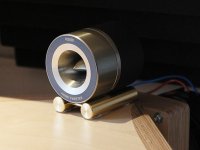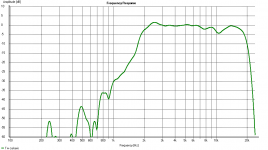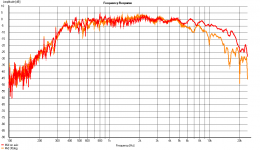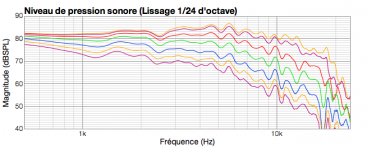Just a reminder to those in the Pacific Northwest, on the last Saturday in August, Gary will be playing is speakers and gear at the PNWAS/ Sound DIY Club DIY Audio get-together on Mercer Island, Washington. Best of all it's free to get in and parking is as well.
Best Regards,
TerryO
Any particulars on where, the date, how to sign up, where to stay? And are other systems (DIY speakers, DIY amps) welcome?
Thanks
Hello Gary and Lynn!
I will will hopefully know very soon much more about these drivers... but "only" Aluminium ;-)
Concerning the corresponding round horn let me ask a question. I have read a lot now about these kind of horns like LeCleac'h, tractrix or spherical. Many people say that these horns have pronounced beaming towards high frequencies and a limited point of listening where the soundstage is "right". Did you ever validated this by measurents under different angles? And if so - or not - is it meaningful or not? So, asking more forward: is beaming an issue with these horns or does is not hurt much?
Thanks!
Bernd
I will will hopefully know very soon much more about these drivers... but "only" Aluminium ;-)
Concerning the corresponding round horn let me ask a question. I have read a lot now about these kind of horns like LeCleac'h, tractrix or spherical. Many people say that these horns have pronounced beaming towards high frequencies and a limited point of listening where the soundstage is "right". Did you ever validated this by measurents under different angles? And if so - or not - is it meaningful or not? So, asking more forward: is beaming an issue with these horns or does is not hurt much?
Thanks!
Bernd
Here are some measurements of a similar system:
http://www.diyaudio.com/forums/multi-way/100392-beyond-ariel-614.html#post4173924
My impression is that the beaming does not hurt the subjective experience in stereo, but I have kept the room pretty live to compensate somewhat for the high directivity index and the stereo image is obviously still much better equidistant from both speakers. I also prefer the imaging of high DI systems more than most people do.
http://www.diyaudio.com/forums/multi-way/100392-beyond-ariel-614.html#post4173924
My impression is that the beaming does not hurt the subjective experience in stereo, but I have kept the room pretty live to compensate somewhat for the high directivity index and the stereo image is obviously still much better equidistant from both speakers. I also prefer the imaging of high DI systems more than most people do.
Any particulars on where, the date, how to sign up, where to stay? And are other systems (DIY speakers, DIY amps) welcome?
Thanks
Look at: 2017 PNW DIY Show here in DIY Audio under "Clubs & Events"
Last edited:
...
Many people say that these horns have pronounced beaming towards high frequencies and a limited point of listening where the soundstage is "right". Did you ever validated this by measurents under different angles? And if so - or not - is it meaningful or not? So, asking more forward: is beaming an issue with these horns or does is not hurt much?
Although I'm not Gary nor Lynn... I was wondering about this too, until I built a pair similar to Gary's. IMO this particular effect is not a show stopper subjectively. The sound is a little "darker" when listening way off axis. In the big picture this is not a big deal. I am glad I did not let this stop me.
Regards - Pierre
Hi,
Can Gary or Lynn comment on the sound of the 6SN7 Amity vs the traditional 5687/7199/etc... Amity? Also, with the high Rp input/driver are there bandwidth issues? Is there a schematic available for study?
Thank you very much! I really appreciate it.
Kindest regards,
Can Gary or Lynn comment on the sound of the 6SN7 Amity vs the traditional 5687/7199/etc... Amity? Also, with the high Rp input/driver are there bandwidth issues? Is there a schematic available for study?
Thank you very much! I really appreciate it.
Kindest regards,
Concerning the corresponding round horn let me ask a question. I have read a lot now about these kind of horns like LeCleac'h, tractrix or spherical. Many people say that these horns have pronounced beaming towards high frequencies and a limited point of listening where the soundstage is "right". Did you ever validated this by measurents under different angles? And if so - or not - is it meaningful or not? So, asking more forward: is beaming an issue with these horns or does is not hurt much?
Thanks!
Bernd
Conicals are effectively the opposite of a LeCleac'h profile. Conicals have reasonably uniform directivity within the cone they radiate (if you can see the phase plug, you can hear it), but shut off rather abruptly outside the cone of radiation. (Walk around one while music is playing and hear it for yourself.)
The LeCleac'h, and to some degree the Tractrix, are rather different. They are like big direct-radiators, and have similar polar patterns and tonal qualities. The further you move off-axis, the duller they are, but there is no sudden cutoff zone when you step outside the beam. Think of a 1.4" dome tweeter with far greater dynamics (20 dB) but similar spatial qualities.
Subjectively, I find some loss of focus and precision when you get 15~20 degrees or more off-axis, so I prefer to aim the horns so they cross about 1~2 feet in front of the listener ... this puts a centrally sitting listener within 5~10 degrees of the center of the pattern.
A secondary reason to use a supertweeter coming in around 5~7 kHz is an improvement in HF dispersion, but then you have to find a supertweeter with performance superior to the Radian 745P with beryllium diaphragm. Some of the higher-grade Fostex supertweeters might qualify, or maybe one of the better European AMT-style tweeters. A combination of very high power-handling, response extending beyond 30 kHz, and smooth response in the passband would be desirable. If the newly revived Ionovac was available to constructors, that would be my first choice.
Last edited:
Need a Passive Crossover schematic for Beyond the Ariel
Hi,
I followed on this thread and built a LF enclosure along the lines of a Onken design with a Altec 416 LF and Altec 288C HF mounted on a Azura 425 horn. Been using along the suggested crossover points on this thread using a mini-DSP. Did not like the active crossover beyond a point and I am reverting to a passive crossover now.
Will need help from anyone here for a passive crossover schematic for Beyond the Ariel project. Can't seem to find one. Most of the links have expired.
Thanks in advance.
Anil
Hi,
I followed on this thread and built a LF enclosure along the lines of a Onken design with a Altec 416 LF and Altec 288C HF mounted on a Azura 425 horn. Been using along the suggested crossover points on this thread using a mini-DSP. Did not like the active crossover beyond a point and I am reverting to a passive crossover now.
Will need help from anyone here for a passive crossover schematic for Beyond the Ariel project. Can't seem to find one. Most of the links have expired.
Thanks in advance.
Anil
I have found some interesting investigations about diffent horns and a measurement of a tractric horn under different angles:
DIY-HIFI-Forum - Einzelnen Beitrag anzeigen - Vergleich von Hornkonturen
Looks like pronounced beaming but on the same side quite smooth.
You mentioned dome tweeters. I heard them many times and also remember some beaming but do ot know how this compares in a qualitative way to these horns in discussion.
A really different approach are designs like this:
http://www.alg-audiodesign.com/portfolio-items/arai-a-290/
Does anybody have experiences with these horns comparable to Smith or TAD TH4001?
DIY-HIFI-Forum - Einzelnen Beitrag anzeigen - Vergleich von Hornkonturen
Looks like pronounced beaming but on the same side quite smooth.
You mentioned dome tweeters. I heard them many times and also remember some beaming but do ot know how this compares in a qualitative way to these horns in discussion.
A really different approach are designs like this:
http://www.alg-audiodesign.com/portfolio-items/arai-a-290/
Does anybody have experiences with these horns comparable to Smith or TAD TH4001?
A secondary reason to use a supertweeter coming in around 5~7 kHz is an improvement in HF dispersion, but then you have to find a supertweeter with performance superior to the Radian 745P with beryllium diaphragm. Some of the higher-grade Fostex supertweeters might qualify, or maybe one of the better European AMT-style tweeters.
The Fostex T925A (see pic below) is what I use, crossed over to my Be-equipped large-format compression driver at 6kHz.
It is very efficient (108dB/W(m)), with a rather flat FR (see my own gated measurement below, on axis), and with an approximately 90º dispersion angle up to beyond 10kHz.
Given the "right" recordings, it gives a very realistic sense of "air" to the UHFs, without imparting any harshness.
Marco
Attachments
Last edited:
A really different approach are designs like this:
http://www.alg-audiodesign.com/portfolio-items/arai-a-290/
Does anybody have experiences with these horns comparable to Smith or TAD TH4001?
I am using these similar ones myself:
Arai A-290 FL – A.L.G. Audio-Design
They are basically the same design, but without the "fins" / vanes in the first section (the side walls are more curved to compensate, of course).
I didn't like the idea of having diffraction-inducing "obstacles" in my horns...
OTOH, precisely because they lack such "fins", they do beam beyond approx. 6kHz: see my (non-gated) MLS measurements below. But I regarded this as the lesser evil, and counteracted it by integrating a super-tweeter (see previous post).
Marco
Attachments
Found some of my old measurements taken in room, from zero to 60 degrees off axis, of the Radian 745NeoBPB-16 Beryllium driver on the LeCleac'h profile Azura 425 horn. The driver is not equalized on these. As Lynn pointed out, there is no cutoff angle to speak of. Note the well-behaved (gradual and smooth) roll off.
Attachments
Will need help from anyone here for a passive crossover schematic for Beyond the Ariel project. Can't seem to find one. Most of the links have expired.
Thanks in advance.
Anil
For optimal integration, you want the woofer and the horn-loaded mid to 'phase track' over a reasonable range of frequencies around the chosen crossover point.
Given the physical offset between the two acoustic centres dictated by the position of the horn on top of the bass cabinet, this will be tricky to achieve with a passive crossover, and it will typically require an ad-hoc asymmetric design with a significantly steeper slope on the woofer branch (from experience, at least 4th order LP / 2nd order HP, but often 6th order LP / 2nd order HP, or even 8th order LP / 2nd order HP).
It can be done, but it isn't easy.
(And incidentally, given the requirement for several inductors connected in series on the woofer branch, in order to minimize the resulting insertion losses one had better use inductors wound with heavy-gauge copper wire, which tend to be expensive...)
Marco
Last edited:
Found some of my old measurements taken in room, from zero to 60 degrees off axis, of the Radian 745NeoBPB-16 Beryllium driver on the LeCleac'h profile Azura 425 horn. The driver is not equalized on these. As Lynn pointed out, there is no cutoff angle to speak of. Note the well-behaved (gradual and smooth) roll off.
Interesting, thanks for posting.
I see already -6dB 30º off axis at ~5kHz, compared to essentially 0dB for my horns up to the same frequency. But then, as you say, mine "nose dive", while the Azura just keeps narrowing its pattern gradually. Pick your poison ;-)
I am using these similar ones myself:
Arai A-290 FL – A.L.G. Audio-Design
They are basically the same design, but without the "fins" / vanes in the first section (the side walls are more curved to compensate, of course).
I didn't like the idea of having diffraction-inducing "obstacles" in my horns...
OTOH, precisely because they lack such "fins", they do beam beyond approx. 6kHz: see my (non-gated) MLS measurements below. But I regarded this as the lesser evil, and counteracted it by integrating a super-tweeter (see previous post).
Marco
Hello marco!
Form my understanding the fins are NOT diffration inducing "devices". The calculated horn contour is calculated with these fins. The opening should be mathematical correct following the underlying model. I think this is comparable to the muticell horns.
Found some of my old measurements taken in room, from zero to 60 degrees off axis, of the Radian 745NeoBPB-16 Beryllium driver on the LeCleac'h profile Azura 425 horn. The driver is not equalized on these. As Lynn pointed out, there is no cutoff angle to speak of. Note the well-behaved (gradual and smooth) roll off.
Pretty much head in vice single person listening. Imaging might be really good in the vice spot, and maybe the tone.. just don't move.
Look at: 2017 PNW DIY Show here in DIY Audio under "Clubs & Events"
Ahhh. Can't do it.
Small matter of my daughter's wedding that day
Hello marco!
Form my understanding the fins are NOT diffration inducing "devices". The calculated horn contour is calculated with these fins. The opening should be mathematical correct following the underlying model. I think this is comparable to the muticell horns.
Agreed that they are not intended to induce diffraction, and that the horn contour takes them into account.
However, my point was/is that being what they are and where they are, they will inevitably induce some diffraction as an unintended side-effect.
Marco
Ahhh. Can't do it.
Small matter of my daughter's wedding that day
Wow, congratulations!
So...pick some other day and stop by for a listen. From Portland, it doesn't take any longer to drive to Silverdale than to Seattle.
Also, I have occasionally hosted meetings of Sound DIY (our local DIY audio club) at my home. If you send me a PM with your contact info, I can let you know next time we set one up.
- Home
- Loudspeakers
- Multi-Way
- Beyond the Ariel



